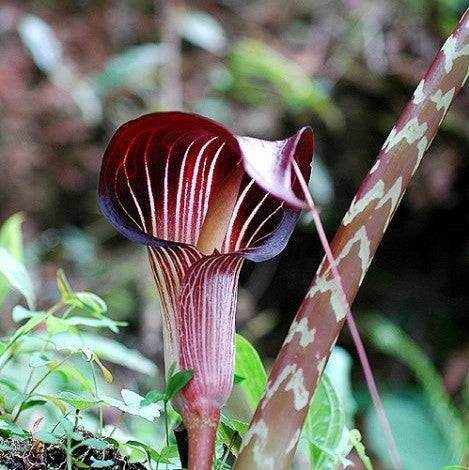Arisaema, commonly known as jack-in-the-pulpit or cobra lily, is a genus of unique and intriguing flowering plants that belong to the Araceae family. Native to Asia and North America, these plants have captured the attention of botanists and enthusiasts alike due to their distinctive characteristics and fascinating life cycle. Here are five captivating facts about Arisaema:
1. Unconventional Flower Structure: One of the most distinctive features of Arisaema is its unique flower structure. The spathe, resembling a preacher's pulpit, envelops and shelters the spadix, often referred to as the "jack." This peculiar design serves a purpose beyond aesthetics. The spathe's role is to attract pollinators, such as flies, by emitting an odor that resembles rotting meat, while the spadix heats up, further intensifying the scent. This imitation of animal matter not only draws pollinators but also enhances the chances of successful pollination.
2. Gender-Bending Plants: Arisaema species can be either male, female, or even change their gender as they mature. This phenomenon, known as protandry, helps prevent self-pollination and promotes genetic diversity within populations. When a plant first blooms, it typically functions as a male, shedding pollen to fertilize other plants. As the plant ages, it transitions to the female phase, producing berries containing seeds.
3. Underground Energy Storage: These plants have a fascinating method of energy storage. Arisaema species produce a corm, a modified underground stem that stores energy in the form of starch. This corm allows the plant to survive adverse conditions such as winter or periods of drought. As the environment becomes favorable, the corm provides the energy needed for the plant to produce new leaves and flowers.
4. Mutualistic Relationships: Arisaema has developed intriguing relationships with various organisms. Some species have a mutualistic association with ants. The plants provide the ants with nectar, while the ants, in turn, protect the plant from herbivores. Additionally, the plant's unique odor also attracts certain fly species, which aid in pollination.
5. Cultural Significance: In various cultures, Arisaema holds special meaning and uses. For example, indigenous tribes in North America have utilized certain species for medicinal purposes. The corms of certain Asian species are used in traditional medicine as well. Furthermore, these plants often find their way into art and literature due to their captivating appearance and unusual biology.
In conclusion, Arisaema stands out as a remarkable genus of plants with its extraordinary flower structure, gender-changing abilities, energy storage mechanisms, mutualistic partnerships, and cultural significance. Exploring the world of Arisaema not only offers insights into the wonders of the natural world but also highlights the intricate relationships between plants and their environments.


